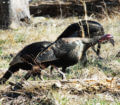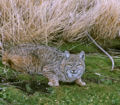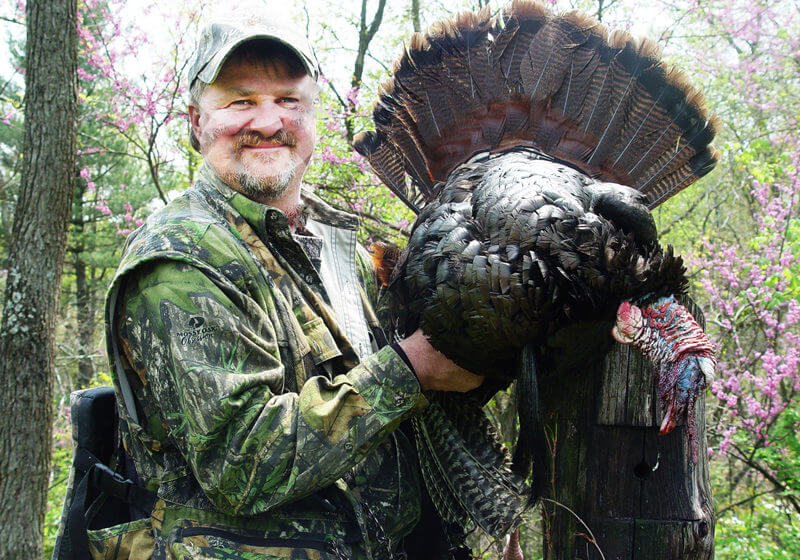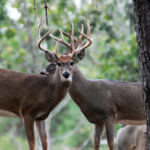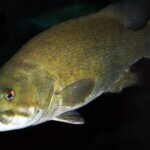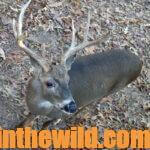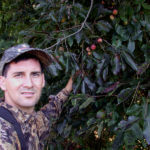Editor’s Note: Avid turkey hunter Tracy Groves of Eldersburg, Maryland, enjoys all types of hunting, including bear and deer, but says hunting turkeys is his first love.
 Most hunters know that one of the ways you often can make a turkey shock gobble is to blow a crow call. So, they may pay attention and listen when they hear a crow call. However, when a woodsman hears what sounds like a crow convention going on, he needs to realize that those crows may have spotted a turkey out in a field or in the woods. For some reason, crows like to drive turkeys nuts. If I hear multiple crows calling all at the same time like delegates at a convention screaming and hollering to get the chairman’s attention, I’ll move toward the crow convention, especially if I’m hunting in woods that are broken up by fields. Sometimes, turkeys will gobble when the crows start screaming, and sometimes they won’t. However, I’ve learned to go to the crows, and I’ll often find a gobbler.
Most hunters know that one of the ways you often can make a turkey shock gobble is to blow a crow call. So, they may pay attention and listen when they hear a crow call. However, when a woodsman hears what sounds like a crow convention going on, he needs to realize that those crows may have spotted a turkey out in a field or in the woods. For some reason, crows like to drive turkeys nuts. If I hear multiple crows calling all at the same time like delegates at a convention screaming and hollering to get the chairman’s attention, I’ll move toward the crow convention, especially if I’m hunting in woods that are broken up by fields. Sometimes, turkeys will gobble when the crows start screaming, and sometimes they won’t. However, I’ve learned to go to the crows, and I’ll often find a gobbler.
Another critter that can really tell you a lot, if you’re looking and listening to woods sounds, is a chipmunk. If a chipmunk feels comfortable and safe, he’ll come out of a log, stand there and feed on acorns and anything else he can find to eat. Anything that spooks a chipmunk will spook a turkey. So, if you’re sitting in the woods, and chipmunks are nearby, and you spook those chipmunks, if a gobbler’s close, you’ll spook him too. The next time you’re in the woods, and a chipmunk is near you, move your finger, your hand or your foot, and watch what happens. Even though the chipmunk is very small, it’s very aware of everything around him. If you can sit next to a tree, and chipmunks are playing all around you, you’re not spooking them. You know that your camo is doing what it’s supposed to do – make you invisible in the woods. However, if a chipmunk comes out of a log and starts looking at you and chirping, you know he’s spotted you. If that little chipmunk can see you, a turkey can see you. So, you need to move to a new location, build a blind or pull your britches’ legs down, so the chipmunk can’t see the tops of your socks above your boots. Very few people pay attention to the chipmunks, but a woodsman does.
 The white-tailed deer is also a true indicator of what will happen when a turkey comes in to where you’ve set-up. If you can hear and have deer moving all around you when you’ve set-up to call a turkey, if those deer don’t get spooked, and if you stay motionless when a gobbler is coming in, you can bet that tom probably won’t get spooked either. If a deer comes up behind you, smells your human odor and starts snorting and blowing, you can bet that the deer is telling the turkey you’re trying to call in that there’s danger. If a deer is alerted in any way, you can be sure he’s going to alert a turkey to your presence and the turkey will be alert and searching for danger.
The white-tailed deer is also a true indicator of what will happen when a turkey comes in to where you’ve set-up. If you can hear and have deer moving all around you when you’ve set-up to call a turkey, if those deer don’t get spooked, and if you stay motionless when a gobbler is coming in, you can bet that tom probably won’t get spooked either. If a deer comes up behind you, smells your human odor and starts snorting and blowing, you can bet that the deer is telling the turkey you’re trying to call in that there’s danger. If a deer is alerted in any way, you can be sure he’s going to alert a turkey to your presence and the turkey will be alert and searching for danger.
To learn more about turkey hunting, check out John E. Phillips’ print, Audible and Kindle turkey books at https://johninthewild.com/books/#turkey. For a free copy of John E. Phillips’ “The Turkey Gobbler Getter Manual,” go to https://johninthewild.com/free-books/.

